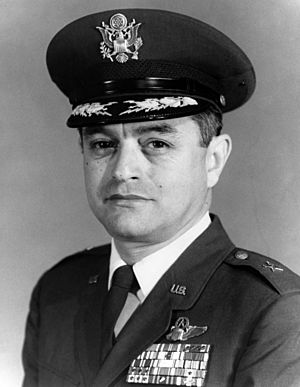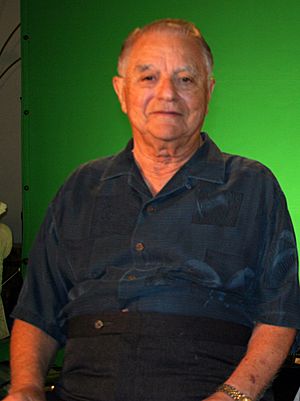Robert Cardenas facts for kids
Quick facts for kids
Robert Cardenas
|
|
|---|---|

Cardenas in the late 1960s
|
|
| Birth name | Robert Leon Cardenas |
| Nickname(s) | Bob |
| Born | March 10, 1920 Mérida, Yucatán, Mexico |
| Died | March 10, 2022 (aged 102) San Diego, California, U.S. |
| Allegiance | |
| Service/ |
|
| Years of service |
|
| Rank | |
| Commands held | Vice commander, Sixteenth Air Force, 1969 USAF Special Operations Force, 1968 835th Air Division, 1966 18th Tactical Fighter Wing, 1964–66 51st Fighter Interceptor Wing, 1955–57 51st Fighter Interceptor Group, 1955–57 51st Maintenance & Supply Group, 1955–57 |
| Battles/wars | World War II Vietnam War |
| Awards | Air Force Distinguished Service Medal Legion of Merit (2) Distinguished Flying Cross Purple Heart Meritorious Service Medal Air Medal (5) |
| Other work | Executive |
Robert Leon Cardenas (March 10, 1920 – March 10, 2022) was a brave and skilled general in the United States Air Force. He was known for his amazing flying skills and for testing many different types of aircraft.
Contents
Early Life and Dreams of Flight
Robert Cardenas was born in Mérida, Yucatán, Mexico. When he was five, his family moved to San Diego, California. He was very good at math and science in high school.
As a teenager, Robert became very interested in airplanes. He loved building models and learning about gliders at the Torrey Pines Gliderport. His excellent grades helped him get into San Diego State University.
Joining the Military
Starting His Air Force Journey
In 1939, while still in college, Robert joined the California National Guard. The next year, in 1940, he became an aviation cadet. This meant he was training to become a pilot.
In July 1941, he earned his pilot wings and became a second lieutenant in the Army Air Corps. In 1942, he helped set up the Army Air Corps Glider School in California.
Later, he moved to Wright-Patterson Air Force Base in Ohio. There, he became a flight test officer. He quickly rose in rank, becoming an operations officer and then the director of the Flight Test Unit.
World War II Heroics
In 1944, Robert Cardenas was sent to England to join the 506th Bombardment Squadron. This group was also known as the Flying Eightballs. He flew his first mission on a B-24 Liberator bomber on January 24.
On March 18, Captain Cardenas was leading his group on his 20th mission. His plane, the B-24 "Sack Artists," was hit by German anti-aircraft fire. The right wing was badly damaged, and two engines caught fire.
Even with the damage, he tried to continue the mission. But his plane was too badly hurt. Pieces of the explosion even hit his helmet, injuring his head. The plane was losing control, so the crew had to parachute out.
Escaping Capture
Captain Cardenas landed on the German side of Lake Constance. To avoid being captured, he swam across the lake to the Swiss side. Switzerland was neutral during the war.
He was first held in a camp for American officers. Later, he taught Swiss officers how to fly American bombers that had landed in Switzerland. On September 27, 1944, Cardenas escaped into France. He got help from Swiss civilians and the French Resistance. He was then flown back to Britain and finally to the United States to recover from his injury.
In November 1944, he went to a special school for B-24 instructors. After that, he became a test pilot again at Wright Field. He became a chief test pilot for bomber aircraft.
Testing New Planes
After the war, in 1945, Robert Cardenas began flying experimental aircraft. He even piloted captured German jet fighters like the Messerschmitt Me 262 and the Arado Ar 234 jet bomber. He also flew new American planes like the XB-42 Mixmaster and XB-43 Jetmaster.
In 1947, he was the pilot in charge of the Boeing B-29 Superfortress that launched Captain Chuck Yeager. Yeager then became the first person to fly faster than the speed of sound in the Bell X-1 experimental plane.
In 1948, Major Cardenas was the chief Air Force test pilot for the Northrop YB-49 flying wing. He even flew the YB-49 across the country. After this flight, President Truman asked him to fly the plane very low over Pennsylvania Avenue in Washington, D.C.
During the Korean War, he continued testing new fighters and bombers. He also served in Okinawa and at The Pentagon.
Vietnam War and Leadership Roles
During the Vietnam War, Cardenas flew combat missions in the Republic F-105 Thunderchief. He then became a trainer for the F-105 at McConnell AFB.
In 1968, Colonel Cardenas was promoted to Brigadier General. He was put in charge of the Air Force Special Operations Force. After that, he became the vice commander of the 16th Air Force in Spain. There, he helped negotiate the withdrawal of U.S. forces from a base in Libya.
His final assignment was in Belgium, working with the Supreme Headquarters Allied Powers Europe (SHAPE). He helped with a plan called LIVE OAK, which was a joint effort by the United States, Great Britain, and France to respond to the Soviet blockade of Berlin.
General Cardenas retired from the Air Force in 1973.
Life After the Military
After retiring, Robert Cardenas worked as an executive in private companies. He also served in several important public roles.
In 1983, President Ronald Reagan appointed him to a group focused on economic action along the U.S.-Mexico border. In 1985, he became chairman of a group that advised on juvenile justice. He also served on the California Council of Criminal Justice.
In 1987, he was appointed to the California Veterans Board, eventually becoming its chairman. In 1993, he resigned from this board to lead the San Diego United Veterans Council. He also became a director on the Board of the Veterans Memorial Center & Museum in San Diego.
Cardenas was also a member of the Veteran Administration's Memorials and Cemetery Committee. He was a trustee of the Flight Test Historical Foundation at Edwards AFB as well.
Robert Cardenas lived in San Diego with his wife, Gladys. He passed away on March 10, 2022, on his 102nd birthday. He was buried with full military honors at Miramar National Cemetery.
Awards and Honors
Military Awards
Robert Cardenas received many awards for his service, including:
- Air Force Distinguished Service Medal
- Legion of Merit (twice)
- Distinguished Flying Cross
- Purple Heart (for his head injury during World War II)
- Meritorious Service Medal
- Air Medal (five times)
He also received the Cross of Aeronautical Merit from Spain.
Civilian Honors
Robert Cardenas was honored many times for his contributions:
- In 1993, the University of New Mexico's Department of Engineering honored him.
- In 1995, he was inducted into the Aerospace Walk of Fame in Lancaster, California.
- In 2004, he was recognized as a Distinguished Alumnus of the U.S. Air Force Test Pilot School.
- In 2008, he was inducted into the International Air & Space Hall of Fame at the San Diego Air & Space Museum.
- In 2012, he was honored at the Air Command and Staff College's Gathering of Eagles.
- In 2015, he was inducted into the National Aviation Hall of Fame.
See also
- Hispanics in the United States Air Force
- Hispanic Americans in World War II


